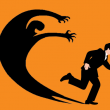by Hubert Marleau, Market Economist, Palos Management
During my absence, front page headers were mainly negative, not least “The Americans Are Humiliated by the Taliban as the U.S. Is Driven out of Kabul”; Wall Street Moves Up Taper Timeline as Fed is Taken Literally”; “Economists Trim Forecasts as Investors Feel Jitters Over Delta Variant”; “The Coronavirus is Endemic”; “Chinese Growth is Slowing Down” and “ Looming Showdown Over the Debt Ceiling” and “The Bill To Pay the Pandemic Will Come Due”.
Despite a veritable litany of terrifying and chaotic headlines and the incorrect but general belief that valuation metrics were nosebleed high, equities took in $24 billion last week, the largest haul in two months of which $12.8 billion was directed into U.S. stocks.
Investors are aware that there is always something wrong somewhere, uncertainties at some point or hardships on some occasion. While unpredictability and lack of definition are constant causes for concern, we should be reminded that Churchill was correct in saying that an optimist is one who finds opportunity in difficulties, and a pessimist is one who finds difficulty in opportunities. It explains why seasoned investors are essentially predisposed to constructive views of the future, no matter what the media says.
For example, the market decided to take a two week pause. The dog days of August, which are notorious for their low volume of trading and nonchalant behaviour, neglected Churchill’s dictum until the last day of the biweekly session, when the market hit a high note. The S&P 500 closed at 4442 on August 20, registering a minute bi-weekly gain of 5 points or a mere 0.1%.
The question is where we are now. Confusion and controversy reign. The market is bifurcated. Polling data for several months have suggested that Americans are not quite sure what to make of the recovery and ensuing expansion. According to Bloomberg, people are roughly evenly split between positive and negative views--a big difference from earlier in the pandemic, when things were obviously bad, and from pre-Covid times, when the good times rolled. Divided views are evidenced in the financial markets. In the last two weeks, ten-year bond yields are up, but inflation expectations are down. Gold prices are flat but Bitcoin prices are up. Food prices are up but oil prices are down. Copper is having a tough time, but thermal coal, metallurgical coal, steel and aluminum are doing well. The dollar (DXY) is strong, yet the Fed is the only central bank that I know of which has effectively raised its inflation target to 3% from 2%. The yield curve has flattened, but leading indicators are beating expectations on the upside. Lastly, market volatility is up, but stock prices are only marginally higher.
When it’s all said and done, the two big major risks are “cyclical inflation” and “flash recession”, which are directly dependent on the conduct of monetary policy. A key bond market indicator is the extra yield that investors demand for holding a thirty-year bond over a five-year note. It gives a pretty accurate feeling on how near-term monetary policy is expected to influence the long-term economic outcome. The basic reason is that the five-year yield reflects what is considered the neutral rate—a rate that is neither cold nor hot that can keep the economy in a proper equilibrium.
Widening spreads are normally associated with easing monetary stances that usually spur growth and inflation while shrinking spreads are usually associated with tightening stances. This closely watched differential has narrowed considerably since last April, suggesting that the outlook for inflation and growth is slowing to the level that the economy experienced before the pandemic hit. According to a study by David Wilcox and David Reifschneider of the Peterson Institute for International Economics, the Fed’s higher inflation goal could bring about a real growth above the 1.75% trend of the last two decades. Acknowledging that commodity prices are falling, the yield curve is narrowing and many would-be workers are leaving the labour force, the anticipated increase in economic growth will have to come from productivity gains. Using Bank of America’s expression “the barn door is open”, for as long as this crucial 30/5 year yield spread stays between 1.0% and 1.4% volatility will likely be hard to swallow but the basic premise should hold.
There is support for the aforementioned hypothesis. The money supply has stopped expanding, suggesting that inflation will be kept in check below 3.0%, while the loan-to-deposit ratio at the banks is at an historic low and therefore enough to finance productivity enhancing investments. Edward Yardeni, a very clever and independent market economist, believes that we are in the early phase of a dramatic productivity boom where productivity growth, currently around 2.0%, could double to 4.0% by the middle of this decade and stay there for a while. Interestingly, observers of technology application are finding that the benefits are not merely confined to efficiencies but also to the quality of services and goods. What we have is a win-win situation. The diffusion of technology will tend to allow wage rates to rise faster than prices, and profit margins and revenues to rise faster than they would otherwise.














